R. CRUMB AND THE BIRTH OF UNDERGROUND COMIX
A 50th Anniversary Celebration
(A History of Sorts but Not At All Encyclopedic or Even Complete; Just Enjoy— Join the Festivities, In Progress)
BEFORE THE YEAR 2018 slips away into a cloudy past, we must pause to remember that it was just 50 years ago that underground comix got their official start on the streets of The Haight in San Francisco. Dunno why this milestone hasn’t been more remarked upon this year. Could be because it’s not entirely clear that 1968 was, in fact, the year that it started. When, during the San Diego Comic-Con last month, I ran into Denis Kitchen, who was there back then and ought to know, he thought it began in 1967. And in a way, maybe it did.
During that storied hippie summer of love in 1967, an estimated 75,00 young Americans put a flower in their hair and went to San Francisco,1* and as soon as they hit the City by the Bay, they gravitated to hippie Mecca, "The Haight," where they started getting better all the time. (Footnotes marked with an asterisk, as this one is, are lengthy and offer more information as well as simply citing a source. They should, probably, be included in the text, but I didn’t want to interrupt the flow of this deathless prose, so I footnoted. Now let me resume—:) On any late afternoon that summer, Haight Street between Central and Shrader swarmed with humanity, both on foot and in cars. Vehicles moved at a dead crawl because the streets were jammed, sometimes with pedestrians who chanted "Streets are for the people" as they walked beatifically into intersections without regard for four-wheeled traffic.
The scene was part Old Calcutta and part carnival midway. The teeming throngs of mostly young people were dressed in Indian paisley prints and T-shirts, Levis and boots and psuedo Western garb, scraps of Army and Navy surplus, and remnants of by-gone fashions culled from local thrift shops; some wore beads and tinkling anklet bells and buttons with cryptic messages on them ("Frodo Lives," "Haight Is Love," "Freak Freely"). A few of the milling multitude passed out flyers and broadsides or, on Fridays, sold copies of the radical underground paper from across the Bay, The Berkeley Barb, or the milder neighborhood publication, The Oracle, which, by summer, was being printed in a rainbow of changing hues that rendered it all but unreadable; others along the street unabashedly hawked drugs ("Acid? Speed? Lids?").
Some gathered around the periodic Grayline tour bus and held mirrors up to the windows for the tourists to see themselves in. (An ironic exercise since most of those in the street were themselves visitors to the vicinity rather than residents.) A few carried tiny bells or tambourines or feathers or bits of fur that they would hold in the faces of other stoned trippers to "blow their minds." Teenie-bopper runaways with dirty faces hoped for a little help from their friends and begged for spare change.
It was street theater, a participatory art form peculiar to the sixties, particularly to the psychedelic community in The Haight, which Charles Perry, an associate editor of Rolling Stone, once described as "a perfect theater, a large territory full of stoned people making the scene and vaguely waiting for something to happen."2 The world's first Be-In had been held earlier in the year (January 14) in the polo grounds at the Golden Gate Park a few blocks west of The Haight; it was a "happening" at which the only event of note was simply the presence of people, amply entertained by themselves and a selection of speakers and rock bands. It was the kind of thing for which The Haight was, by then, renowned.
"The Haight" was hip for the Haight-Ashbury District, a huddle of rundown Victorian houses and somewhat seedy storefronts at the east end of Golden Gate Park and separated from the rest of the city by the wooded hills of Ashbury Heights. Although the population was chiefly Poles and Czechs who had lived there since before World War II, students at the nearby University of San Francisco had begun to infiltrate the neighborhood a few years before to take advantage of the low rents, and an art colony was in full flower. By 1967, there was also a conspicuous infestation of dope-using drop-outs and hippies. For many of the latter, life revolved around periodic psychedelic rock dance concerts and the musicians and the poster artists whose works celebrated the dances they advertised. The first of these dances had been sponsored by the Family Dog in October 1965 as "A Tribute to Dr. Strange."
That a Marvel Comics character should be so honored was not, at the time, remarkable: Ken Kesey (of “Cuckoo Nest” fame), an early apostle of acid, had toured the vicinity frequently, proclaiming the heroism of everyday life and asserting that the costumed superheroes of Marvel Comics had as much to say about life as most comtemporary literature. And his Acid Trip retinue included the Merry Pranksters, who dressed in costumes like superheroes.
The dances at the Fillmore and Avalon were conceived and staged as participatory art. The stoned crowd circling the dance floor chanted and sang and painted each other's bodies with bright colors, blew whistles and flutes, vibrated in the strobe lighting, and gawked intensely at the walls and ceiling against which light shows displayed changing colors that throbbed in tune with the music's beat. The sound overwhelmed all the senses, enhancing the drug-induced oceanic feeling that "all is one" and that, therefore, everyone was "on the same trip." It was, they believed, a trip of love, peace, beauty, and freedom. Others might observe (more-or-less correctly) that the trip featured chiefly drugs and sex and rock-and-roll parties all night long, but even so, the psychedelic community was an astonishingly peaceful one, compared, say, to the beer-guzzling orgies of college students on spring break at Fort Lauderdale.
The
posters that announced the times and places of the dances had become objets
d'art in themselves. In defiance of conventional marketing custom,
content on the posters was subordinated to design. Early poster artists Wes
Wilson and Stanley "Mouse" Miller became adept at using
bold colors and abstract, mushrooming, twisting shapes that incorporated pop
images and virtually undecipherable lettering into the same design (creating a
product that "made sense only when you were stoned," according to
Perry). The Print Mint, initially founded by Don Schenker as a
framing and printing establishment for fine prints, soon concentrated on
producing dance posters3 and then began commissioning artists to do
posters in a satiric vein.4 Soon the Print Mint would be
publishing yet another satiric product, comic books. 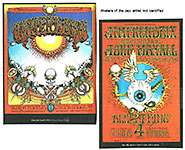
Robert Crumb arrived in the Haight in January 1967, fleeing a wife and an unwanted marriage and a stultifying job at American Greeting Cards in Cleveland. There, he'd been taking LSD and using a little pot for a couple of years, so when he saw some dance posters from San Francisco, he knew the source of the poster artists' inspiration. And he was primed for what he called "the wild and wacky hippie scene at its high noon of acid-induced euphoria."5 Guilt-ridden about his wife Dana, he sent for her after three weeks, and they took an apartment in The Haight; she worked, and he "hung out," smoking dope and listening to rock records and drawing drug-inspired comic strips in his sketchbooks.
He also hitch-hiked back and forth across the country, and it was perhaps on a springtime stop in his hometown, Philadelphia, that he met Brian Zahn, who was about to publish an underground newspaper that he called Yarrowstalks. Zahn took one of Crumb's cartoons, and Mr. Natural saw print in the first issue of the paper, dated May 5, 1967. Zahn liked Crumb's work so much that he invited him to do an entire issue. And when that issue (No.3) sold well, Zahn suggested that Crumb do a comic book which he would publish. Crumb was delighted: he'd been filling his sketchbooks with comic book stories for years and had even designed and drawn covers for such a vehicle. He completed a 24-page issue of Zap Comix in October and sent the artwork to Zahn, then did another 24-page issue in November. Hearing nothing from Zahn for months, Crumb phoned Philadelphia and found out his patron had left the country. And the 24 pages of comic book art were missing.
About that time, Crumb met Don Donahue at the home of a friend. Donahue had seen Crumb's work in the underground newspapers Yarrowstalks and The East Village Other and had tried in vain to locate the cartoonist. Crumb had some of his Zap pages with him, and when Donahue saw them, he eagerly offered to publish the comic book. Donahue traded his hi-fi tape recorder to an old hipster printer named Charles Plymell in exchange for 5,000 copies of what became Zap Comix No.1. It was a uncomplicated production: two colors on the cover; all black and white inside. Its simplicity kept its cost low; it set the mold for the genre.
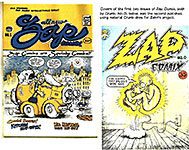 |
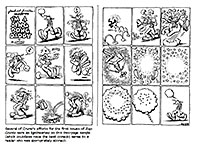 |
"The first issue was printed in February 1968," Crumb recalled. "We folded and stapled all 5,000 copies ourselves and took them out and sold them on the street out of a baby carriage. At first, the hippie shopkeepers on Haight Street looked down their noses at it—‘A comic book? No, I don't like comic books.’ It looked just like a traditional comic book. It had none of the stylings of your typical psychedelic graphics— the romantic figures, the curvy, flowing shapes. It took a while to catch on."6*
But not as long as Crumb implies. Responding to demand, Donahue (calling himself Apex Novelties) did a so-called second printing of the first issue within a month or two in order to replace the inventory that had been destroyed in a fire at his establishment. (It was actually more of a second edition than a second printing because Donahue added four more pages of Crumb material, producing a 28-page magazine.)
Donahue also printed Zap Comix No.2 in June, but Crumb was unhappy with the quality of the printing, and Moe Moscowitz of Moe's Books in Berkeley put up money for the Print Mint to do the later runs of this issue and all subsequent issues. Zap No.2 included contributions from two poster artists, Victor Moscoso and Rick Griffin, and another cartoonist, S. Clay Wilson.
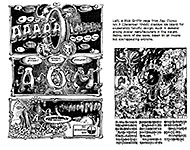 |
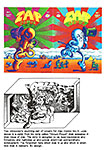 |
By late fall, Crumb comix had become popular enough to stir up a flurry of publishing activity. In December, using photocopies Crumb had made of the "first issue" that he'd sent to Zahn in Philadelphia, the Print Mint published Zap Comix No.0 and, at about the same time, Zap Comix No.3, which added Gilbert Shelton to the roster of Zap regulars. Of the Zap crew, Wilson probably influenced Crumb the most.
Wilson had drifted into Crumb's apartment one day from Nebraska. An art school graduate, Wilson saw himself as an art outlaw whose function was to use his art to puncture the "booshwah" balloon, to strip "the mass delusion" from the eyes of the American middle class. Wilson was a heavy drinker, preferring wine and beer, and Crumb went drinking with him, and they talked into the night.
"A seething, visionary kinda guy, Wilson was very inspiring to be around in those days," Crumb wrote. "I learned a lot from Wilson. He had evolved and articulated his artist-rebel thing to a high degree. He lived the role. By comparison, my conception about what I was up to as an artist was murky, unformed. I was coming from a rather more conventional cartoonist-as-entertainer background. We had long discussions about what this work we were doing was all about. Wilson once said to me, `Fuck entertaining the masses, Crumb! You're just feeding the hungry dog.'"7
Wilson's
contribution to Zap Comix No.2 was violently different from Crumb's
good-natured big-foot material. Wilson drew stories about bikers and
pirates and lesbians and all kinds of unsavory demonic freaks. And he
drew them as grotesque gargoyles, ugly and malformed and repulsive— covered
with blemishes and scars, warts and unruly hair. His graphic style was
raw and uncompromising, and his characters were relentlessly brutish, violent
savages who stabbed and chewed each other to bits whenever they weren't
committing bizarre sex acts. 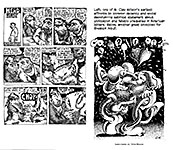 Wilson held nothing back, made no concession to social
convention whatsoever; he relished offending every civilized sensibility.
And he had an effect on Crumb.
Wilson held nothing back, made no concession to social
convention whatsoever; he relished offending every civilized sensibility.
And he had an effect on Crumb.
"Getting involved with these other artists who had very strong personal visions of their own threw me off my track," Crumb said. "For better or worse, the influence of Wilson and [Los Angeles poster artist Robert] Williams began to show in my work. I, too, became more of a rebel. I cast off the last vestiges of the pernicious influence of my years in the greeting card business [and] let it all hang out on the page— the raging Id. Seeing what Wilson and Williams had done just gave me the last little push I needed to let open the floodgates. Blatant sexual images became a big thing, still happy and positive at first— a celebration of sex. [But as time went on], I moved further and further away from mass entertainment. The sexual element became increasingly sinister and bizarre."8*
Crumb and Wilson collaborated in the fall of 1968 on another comic book. Called Snatch Comics, it dealt explicitly with sex. Crumb and Wilson showed penises and penetration, cunninglingus and fellatio. Not since the infamous home-made eight-page Tijuana bibles of the 1930s and 1940s had sex acts been so graphically depicted. Graphically and joyfully. These pages are infused with a giddy glee; even Wilson's contributions are cheerful evocations of sexual fantasies rather than his typically brutal confrontations.
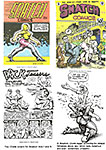 |
 |
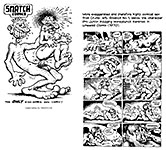 |
Donahue agreed to publish the book on the condition no one would know he printed it. His association with Crumb was coming to a close now that Zap Comix had been taken over completely by the Print Mint (which would venture even further into comix publishing that fall, launching the tabloid newspaper Yellow Dog Comics to which Crumb contributed).
Coincidental with the production of material for the first issue of Snatch, Crumb went to New York and made a startling discovery. He was a celebrity. And his fame was not confined to the counterculture enclaves served by the underground papers he'd cartooned for or by the comic books. He was photographed by Life (although the article never appeared).
"I had suddenly become a phenomenon, another hippie counterculture personality— Mr. Keep-on-Truckin', Mr. Zap Comix. If you were a hip college student, you had to have a Zap comic next to your dope stash. I didn't have any money but I had glory! I was America's best-loved underground cartoonist."9
Just as head-turning as this overnight fame was his sudden success with women. In New York, he met other underground cartoonists— Spain Rodriguez and Kim Deitch and Art Spiegelman— and one night, Spiegelman brought his date and another girl to a restaurant dinner with Crumb. Suddenly, Crumb said, he realized that the extra girl was being "presented" to him. And that she would be completely accommodating.
"I didn't have to say or do anything to earn this wondrous creature's favors," he wrote. "She was mine for the taking simply because I was Thee Famous, Thee Ultra-hip R. Crumb. That was it. If I wanted the chick, I could have her. So this was fame. Incredible— the girl was stunningly cute— a baby-faced seventeen-year-old. I stared at her speechless. Never in my wildest trembling dreams— I was twenty-five, and never in my life had a girl this attractive, this perfect, ever looked at me twice."10
Now, he was to learn, stunningly cute girls of this sort would flock to him, offering their favors without being asked.
Crumb did not consider himself physically attractive to women. Beak-nosed and slightly buck-toothed, he was tall, alarmingly skinny, and wore glasses. The classic adolescent nerd. He had been this gangling clod, it seemed, all his life— but particularly in high school, when, like any healthy teenager, he began to notice girls. Alas, they didn't notice him. Instead, they fawned over boys who were handsome and charming— and also egotistical, aggressive, rough and even mean. Crumb couldn't understand how girls, who always seemed to him more sensitive and more sympathetic than boys, would consistently fall for such "louts" instead of gentler artistic souls like him.11* And because he was too introverted to devise any way of claiming female attention, he continued unnoticed throughout his highschool career.
Born in 1943 in Philadelphia while his father was serving in the Marines during World War II, he was the third of five children. The second born, Robert's older brother Charles, was the leader of the troupe, devising games for them all to play. He and Robert very early discovered a common interest in comic books, and they began writing and drawing their own single-copy comics, imitating the animal characters they found in Walt Disney's Comics & Stories (Carl Barks' ducks), Dell's Animal Comics (where Walt Kelly dominated the pages), New Funnies (Andy Panda), and Terrytoons (Mighty Mouse, Gandy Goose, and Heckle and Jeckle). Their method in creating these "two-man comics" was unique: they worked together, each drawing and dialoguing his own character to which the other made his characters respond. It was an absorbing amusement but it isolated them from other children; for the time being, they lived happily in their own fantasy world.
In 1959, the brothers did a story called "Cat Life" in which a cat named Fred starred; Robert did the hero, and Charles did the villains in the story. In the next cat story, Fred stood up and wore clothes. And he changed his name to Fritz.
Robert was comfortable working with animal characters: "I can express something with them that is different from what I put into my work about humans," he wrote to his friend Marty Pahls at about this time; "I can put more nonsense, more satire and fantasy into the animals. They're also easier to do than people. With people I try more for realism, which is probably why I'm generally better with animals."12 He would continue drawing Fritz the Cat for years and would come to despise the character.
By
1960, after he graduated from high school, Charles had lost interest in
cartooning. Robert kept on drawing, focussing on alter ego characters
that represented "the inner me . . . with the emphasis on the lovelorn
side of my nature."13 He finished high school in 1961 but
stayed at home, drawing, until the fall of 1962, when, prompted by an
invitation from Pahls, he went to Cleveland and soon found a job with American
Greeting Cards. 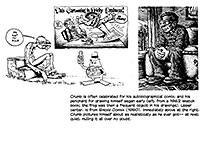
Although his memories of his training period are tinged with a measure of bitterness about the often arduous factory-like mechanics of its operation, Crumb learned a great deal and developed facility with a variety of drawing tools and techniques. By the summer of 1963, his doodling on scraps of paper at his drawingboard had attracted the attention of Tom Wilson. Wilson, who would later create the put-upon cartoon character Ziggy, was then head of the Hi Brows department, which produced the company's new line of wise-cracking cards. That fall, Wilson had Crumb transferred to Hi Brows where creativity was encouraged and rewarded, and Crumb began to enjoy his work more.
Pahls and Crumb rented the third floor of a rooming house on East 115th Street, and the two of them cruised thrift stores and other second-hand outlets for old 78 rpm records, magazines, newspapers, advertisements, posters— any and all artifacts of American popular culture 1920-1940. And Pahls encouraged his roommate to hang out with him at local bars frequented by co-eds from nearby Case-Western Reserve University and highschool girls visiting from Cleveland Heights. But Crumb was still a virgin in the spring of 1964 when he met Dana Morgan, an eighteen-year-old Cuyahoga Community College student with middle-class parents in Cleveland Heights.
She had seen some of his drawings and loved them. Crumb still considered himself "a freak, a four-eyed, star-crossed, skinny loner, with a message impossible to communicate to an uncaring and uninterested world" according to Pahls, and he was therefore easy prey for a girl like Dana. He was immediately smitten by her plumb "robust" figure ("big legs and all that," he said) and "beautiful Krishna-like face with big oval brown eyes."14
And Dana wanted Crumb. At first he rejoiced in their relationship (which was sexually consummated only after a two-month courtship), but before long, her possessiveness began to suffocate him. He fled. Applying to Wilson for a leave of absence, Crumb went to New York that summer.
In New York, he sought out Harvey Kurtzman, whose Mad had stimulated some of the "two-mans" of his youth. Kurtzman was then producing Help! for Jim Warren, and he put Crumb to work assisting Terry Gilliam (later of Monty Python fame) in production chores. And he bought "Fritz Comes on Strong," a two-page episode in which Fritz disrobes his date, apparently intent on having sex with her. He removes one article of clothing at a time (thereby prolonging the suspense), and when she is at last naked, the cat suddenly behaves like a grooming animal: "Now be patient, my sweet," Fritz murmurs, "--them little fleas are hard t'get a hold of."
Crumb also found work in a Greenwich Village quick-draw portrait gallery, a job that moved to the Atlantic City boardwalk for the Democratic National Convention that summer. There, suddenly, Dana appeared and hauled him back to Cleveland and marriage. Then they went to Europe. Crumb arranged a freelance-by-mail contract with American Greetings: Wilson would send him card ideas, and he'd send back finished art. At about $25 a card, it would be enough to keep the couple afloat. They spent the winter in Switzerland, and Crumb filled sketchbooks with comic book stories, many starring Fritz.
The
cat was Crumb's stand-in: he was successful where Crumb was not. He
was a glib-talking ladies man and bon vivant, master of any situation in which
he found himself (particularly those involving the female of the
species). But Fritz was flawed: he was a self-centered hedonist and
prankster without the slightest moral or ethical qualm. He was, as Pahls
said, "a poseur," a phoney. 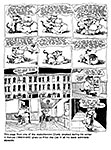 And although Fritz's posturing was taken seriously
by all those around him, Crumb always arranged a comeuppance, keeping his
egotistic protagonist in hot water.
And although Fritz's posturing was taken seriously
by all those around him, Crumb always arranged a comeuppance, keeping his
egotistic protagonist in hot water.
It was, psychologically speaking, the cartoonist's revenge upon those more socially adept than he: he may have envied their success, but by making it clear that their attainments were founded on insincerity and blatant self-interest, he demonstrated that those he envied were not as worthy as, say, he was.
Crumb's graphic style was forming, too. Using the Rapidograph drafting pen that he'd learned about while in training at American Greetings, he gave his outline drawings texture and volume with shading techniques that became increasingly intricate.
Crumb and Dana returned to Cleveland in the spring of 1965, and Crumb resumed his work at American Greetings. Shortly thereafter, he took LSD for the first time; then marijuana. And his marriage, never quite stable (based, as it was, more upon Dana's desire than Crumb's), began to fall apart. He started seeing other women. Then in August, he responded to a call from Kurtzman, who wanted him to replace Gilliam on Help!
But when he and Dana arrived in New York, Warren had just pulled the plug on the magazine. Kurtzman, feeling responsible for Crumb being in New York, tried to find work for him. He also invited him to his house for dinner frequently.
"Kurtzman was my hero," Crumb said. "Hanging out with him was very instructive. He showed me a lot of techniques and told me a lot about the commercial art business, how it worked and what to look for and the pitfalls. He gave me a lot of good advice. He headed me in the right direction. He's probably the only person in my whole life who was a good teacher. The only one. The only person I ever learned anything useful from."15
Crumb didn't work out as an assistant on Little Annie Fanny, but he did work for Topps bubblegum cards, a Kurtzman referral. This led to assignments on several projects being launched privately by the head of Topps' creative department, Woody Gelman, under the imprint of his Nostalgia Enterprises.
Crumb and Dana moved from their Yorkville studio apartment to the East Village in late 1965. Always a bohemian haven, the Village was now making room for the last of the beatniks and the first of the hippies by expanding eastward into the low-rent threadbare district around Tompkins Square. Crumb, taking LSD more and more often, continued to draw his own comics in sketchbooks. And then he picked up a copy of the East Village Other, an underground newspaper, in which he saw his first underground comic strip— Bill Beckman's Captain High, a cartoon celebration of drugs. Dana found a job in the pharmacy at Roosevelt Hospital and brought home handfuls of methadrine tablets. Friends from Cleveland moved to New York, and they spent evenings at the Crumbs', dropping acid and popping pills and talking.
Among
the friends was a girl with whom Crumb had enjoyed an affair before coming to
New York; they resumed their relationship. Dana went back to
Cleveland. A few weeks later, Crumb left for Chicago, where he lived with
Marty Pahls. While there and under the influence of some
"fuzzy" acid he'd taken in New York, he spent days drawing in his
sketchbooks, creating the entire cast of characters that would populate his
comics for years thereafter— Mr. Natural, Flakey Foont, Schuman the Human, the
Snoid, Eggs Ackley, the Vulture Demonesses. 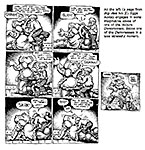
"It was a once-in-a-lifetime experience," he wrote, "— like a religious vision that changes someone's life, but in my case it was the psychotic manifestation of some grimy part of America's collective unconscious."16
Later, Crumb would attribute his emergence as a cartoonist to the "fuzzy" LSD trip (and to taking LSD generally). "I could show you in my sketchbooks where that period starts," he told The Comics Journal’s Gary Groth, "when I was in that fuzzy state, and how my art suddenly went through this change, this transformation in that couple of months." Without this experience, he claimed, his work would have taken a more serious turn. "I probably never would have gotten in to that real ridiculous cartoony phase, where I was basically doing throwbacks to the Popeye-Basil Wolverton-Snuffy Smith style of cartooning. I did that as a joke. That absurdity was such a deep part of the American consciousness, that way of seeing things, and I suddenly rediscovered that in that state. All the dancing images were in that grotesque funny cartoony style with big shoes."17
Homesick for Dana, Crumb suddenly took a bus to Cleveland and rejoined her in the spring of 1966. He also returned to American Greetings and Hi Brow cards, where he worked for the next eight months. It was, he said, "the last time I ever held down a nine-to-five job."18 Restless, he started frequenting bars, and one afternoon in January 1967, two friends told him they were setting out for San Francisco that evening. He went with them. As simple as that: he got in their car with about seven bucks in his pocket and left Cleveland without so much as a phone call to Dana. And eighteen months later, he found himself a famous cartoonist.
The hippie community was ready for comix. The underground newspapers of the growing counterculture had been publishing comic strips that urged revolution and turning on to drugs (among other things) for some time. Underground comic books were the next logical development. And Crumb had already been toying with the idea, producing sketches and plans for a comic book to be called Fug as early as the fall of 1965. He was in the right place at the right time, The Haight in 1967. And as it turned out, he was the right person. The previous summer, he had sold a few strips to the East Village Other as well as Yarrowstalks, but Crumb's greatest contribution to the medium would begin with the comic books he created that fall.
Crumb's work is not remarkable for any great degree of formal experimentation. Except for an early foray or two into eccentric page layout that attempted to suggest the euphoric disorientation of being stoned, most of his work is quite straight-forward conventional comics storytelling. The story unfurls in a quiet succession of regular-shaped panels arranged with drill-team precision in two or three tiers per page. No flashy special effects. No layout tricks. No dramatically engineered timing. Just storytelling straight ahead in unhued black and white.
But in his selection of subjects, Crumb opened broad new vistas by venturing into hitherto unexplored territory. And it was adult territory. At his most sensational, he broke age-old taboos, shattered them; and comics would never again be quite the same.
The first two issues of Zap that he drew, however, are distinguished by their good-humored playfulness rather than by any adventurousness in content. Crumb accurately catalogues his work of 1967-68 as a "sweet, optimistic, LSD-inspired mystic vision drawn in the loveable big-foot style that everyone found so appealing."19 His old-fashioned looking drawings enliven every page with their purely visual comedy: the goofy galoot-style characters look funny. And they also do funny things, often in baffling ways (which nonetheless seem funny because of the farcical appearance of the characters).
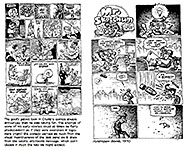 |
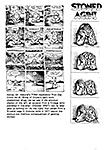 |
In the shorter one- and two-page features, Crumb seems to be toying with the medium, giving us coherent images that, despite the order of their sequence, ultimately make no comedic sense in the ordinary, everyday way. And they doubtless were not intended to make sense in the usual fashion. As fellow underground cartoonist Jack Jackson (Jaxon) said in recalling the early days of comix, "Comix were for aficionados and dopers and whatnot from the beginning. We were just entertaining our friends, so to speak."20 In short, these comix were likely to be funny only to those readers who were stoned at the time.
Jaxon,
who produced in 1964 a prototypical comix, God Nose (Snot Reel), about
the hilarious dilemmas of a bearded, bulbous-nosed dwarf-sized god trying to
fit into the twentieth century, sheds additional light on the matter as he
explains the origin of the book and its title: "We were doing a lot
of peyote in those days, quite legal at the time, and among other things, it
makes your nose drip. So under the influence of this stuff, sitting
around with some of these loony guys, we came up with a character called ‘God
Nose.’ It was strictly drug-induced.... Anyway, God Nose was
an attempt to render some of the ridiculous absurdities that had come through
from these peyote sessions."21 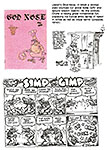
A couple of these earliest Zap stories are satirical in an almost traditional way— "City of the Future," which ridicules blissful futuristic visions; and "Whiteman," which lays bare the repressed middle-class male. But in stories like "Meatball" (about an inexplicable rain of meatballs, hits of acid, that transform everyone struck by one) and "Hamburger Hi Jinx" (in Zap No.2), Crumb continues to play with the subjects in ways that are most amusing, probably, to tripping readers.
The longest stories in both the first issues of Zap record adventures of Mr. Natural, Crumb's Afghanistan cab driver cum guru and con man, a diminutive bald, bearded and robed "wise man" with gigantic feet, whose Zen-like pronouncements doubtless make the best sense only to readers who are turned on. Mr. Natural's nemesis is an up-tight youth named Flakey Foont. After a frustratingly unsatisfying counseling session with Mr. Natural in the desert, Flakey turns to leave, saying, "Ah, you're nuts." "Don't you wish," responds the irrepressible Mr. Natural. "Hey," he goes on, "— know what?" "What?" asks Flakey. "That's what!" says the wise man, exiting stage left. Funny if you're stoned, no doubt.
OUR CELEBRATION of the 50th anniversary of underground comix will continue in the next Hindsight, coming in September. Don’t miss it if you can.
FITNOOTS
1 Charles Perry, The Haight-Ashbury: A History (New York: Random House, 1984), p. 245. All the subsequent description of the Haight is derived from Perry's book. I am also indebted to comics chronicler Clay Geerdes who cheerfully checked the factual accuracy of this essay (years ago, when it was being born). Living in Berkeley, Geerdes began in October 1973 to produce a newsletter about underground comix and related matters. At that time, he also started a journal in which he recorded the day he picked up each new underground comic book. "I know exactly when this or that book came into the Print Mint warehouse in Berkeley or to Last Gasp in San Francisco," he says in "The Dating of Zap Comics," an unpublished manuscript (1994 copyright by Clay Geerdes) from which I quote with permission from time-to-time herein. Although Geerdes was not keeping his journal during the formative period covered on in this essay, his interest in underground cartooning grew over the years, and he tried to get to know as many of the cartoonists as possible. In conversations with them, he picked up knowledge of the early history of comix. And he dug deeper into the matter as he began seeing erroneous assertions in print in various publications.
Geerdes did not agree with Perry’s vision of The Haight. In fact, he strenuously disagreed. And he was there. But so was Perry, and I took Perry’s description because it reflected a certain mood about the place and times, which I thought was at least as important as the less romantic facts Geerdes insisted on. Perry’s atmospherics sounded a lot like New York’s Greenwich Village at about the same time, and I had tripped the light fantastic in the Village in the summers of 1964-1966 and heard an echo in Perry. In the rare instance in which Clay and I are at variance, I acknowledge his alternative position.
2 Ibid., p. 252.
3 Mark James Estren, A History of Underground Comics (San Francisco: Straight Arrow Books, 1974), p. 50.
4 Perry, p. 112.
5 Robert Crumb, "Introduction" to The Complete Crumb Comics, Vol. 4 (Seattle: Fantagraphics Books, 1989), p. x.
6 Ibid., p. xiv. Crumb's recollection isn't quite accurate: Zap Comix No.1 contains one 3-page story that consists entirely of abstractions in irregular-shaped panels. Geerdes says that the magazine was printed on February 24, folded and stapled on the floor of Crumb's apartment that day, and sold on the streets the next day. The first printing wasn't even trimmed, so after folding and stapling, the edges of the magazine's pages didn't line up evenly (p.1 of "The Dating of Zap" and Geerdes' letter to me dated December 10, 1994). The first printing of Zap Comix No.1, incidentally, carries on the back cover the notation "Printed by Charles Plymell." According to Geerdes, the various "printings" of Zap No.1 are virtually meaningless: "Donahue had that [printing] press in the same room where he slept. He could run off a hundred now, a hundred later, a hundred a week later; it wasn't like they went to a regular printer and ordered a specific number of books" (letter to me dated December 24, 1994).
7 Robert Crumb, "Introduction" to The Complete Crumb Comics, Vol. 5 (Seattle: Fantagraphics Books, 1990), p. viii.
8 Loc. cit. Robert Williams lived in Los Angeles and did posters for Big Daddy Roth. He became a contributor to Zap with the fourth issue; he also produced his share of complete comix books over the next few years. Like Moscoso and Griffin, Williams is a marvelously inventive graphic designer. He is also a fantasist of great imagination, and this combination has produced some of the most fascinating of visual inventions. The character associated with Williams' comix work is a mythical insect, Coochy Cooty. The seventh regular Zap contributor was Spain Rodriguez, whose work began appearing with Zap No.6.
9 Ibid., p. vii.
10 Loc. cit.
11 This is Crumb's own self-analysis, presented in two installments of "My Troubles with Women" (Zap Comics, 1980; Hup, 1986; rpt. in My Troubles with Women [San Francisco: Last Gasp, 1992]).
12 Marty Pahls, "Introduction" to The Complete Crumb Comics, Vol. 1 (Seattle: Fantagraphics Books, 1987), p. xi.
13 Ibid., p. xii.
14 Marty Pahls, "Introduction" to The Complete Crumb Comics, Vol. 3 (Seattle: Fantagraphics Books, 1988), p. vii.
15 "The Straight Dope from R. Crumb," interview by Gary Groth, The Comics Journal, 121 (April, 1988), p. 62; also, Pahls, Vol. 3, p. xi.
16 Crumb, "Introduction" to Vol. 4, p. viii.
17 "Straight Dope," p. 70-71.
18 Crumb, "Introduction" to Vol. 4, p. viii.
19 Crumb, "Introduction" to Vol. 5, p. viii.
20 Stanley Wiater and Stephen R. Bissette, eds., Comic Book Rebels: Conversations wih the Creators of the New Comics (New York: Donald Fine, Inc.), p. 38.
21 Ibid., p. 35-6.
